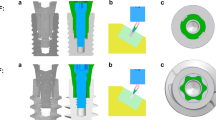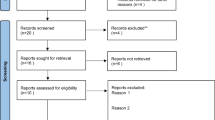Abstract
Micromotion between IAI affects long-term survival rate of dental implants. The use of practical implants for mechanical test is costly. Finite element analysis (FEA) could test the micron level deformation changes, but whether it reflects the in vitro mechanical performances remains unknown. This study aims to investigate the correlation between IAI micromotion of FEA and in vitro performances. The two-step–two-component FEA method was used to test the relative deformation between IAI for three implant designs (M1, M2, and M3) during torque loading and cyclic oblique loading. The micromotion was divided into directions that perpendicular to (x-axis) and parallel to (y-axis) IAI. In vitro experiments on the micromotion relevant performance of IAI microleakage (tested by toluidine blue releasing with a spectrometer) and IAI locked condition (tested by abutment removal force tests after detaching the central screws) were also conducted for the identical implant systems (G1, G2, and G3). One-way ANOVA and Pearson’s correlation tests were performed for data analysis. FEA illustrated that the three implant systems performed different micromotion patterns. Significant differences were found in the IAI microleakage and removal force among the groups. Positive correlations were found between FEA and in vitro outcomes. Therefore, the two-step–two-component FEA method is an appropriate method to evaluate the IAI micromotion after loading.

The correspondence of IAI micromotion between FEA analysis and in vitro performances.












Similar content being viewed by others
References
14801:2007(E) I. (2007) Dentistry - implants- dynamic fatigue test for endosseous dental implants
Abdelhamed MI, Galley JD, Bailey MT, Johnston WM, Holloway J, McGlumphy E, Leblebicioglu B (2015) A comparison of zirconia and titanium abutments for microleakage. Clin Implant Dent Relat Res 17(Suppl 2):e643–e651
Aguirrebeitia J, Muftu S, Abasolo M, Vallejo J (2014) Experimental study of the removal force in tapered implant-abutment interfaces: a pilot study. J Prosthet Dent 111:293–300
Aguirrebeitia J, Abasolo M, Muftu S, Vallejo J (2017) Influence of design and clinical factors on the removal force ratio in tapered implant-abutment interfaces. J Prosthet Dent 117:493–498
Algraffee H, Borumandi F, Cascarini L (2012) Peri-implantitis. Br J Oral Maxillofac Surg 50:689–694
Binon P (2000) Implants and components: entering the new millennium. Int J Oral Maxillofac Implants 15:76–94
Bozkaya De (2004) Efficiency considerations for the purely tapered interference fit (TIF) abutments used in dental implants. J Biomech Eng 126:393–401
da Silva-Neto JP, Prudente MS, Dantas TS, Senna PM, Ribeiro RF, das Neves FD (2017) Microleakage at different implant-abutment connections under unloaded and loaded conditions. Implant Dent 26:388–392
Gehrke SA, Poncio da Silva PM, Calvo Guirado JL, Delgado-Ruiz RA, Dedavid BA, Aline Nagasawa M, Shibli JA (2016) Mechanical behavior of zirconia and titanium abutments before and after cyclic load application. J Prosthet Dent 116:529–535
Gomes RS, Bergamo ETP, Bordin D, Del Bel Cury AA (2017) The substitution of the implant and abutment for their analogs in mechanical studies: in vitro and in silico analysis. Mater Sci Eng C Mater Biol Appl 75:50–54
Gratton D, Aquilino S, Stanford C (2001) Micromotion and dynamic fatigue properties of the dental implant-abutment interface. J Prosthet Dent 85:47–52
Grobecker-Karl T, Karl M (2017) Correlation between micromotion and gap formation at the implant-abutment Interface. Int J Prosthodont 30:150–152
Hagiwara Y (2010) Does platform switching really prevent crestal bone loss around implants? Jpn Dent Sci Rev 46:122–131
Heydecke G, Zwahlen M, Nicol A, Nisand D, Payer M, Renouard F, Grohmann P, Muhlemann S, Joda T (2012) What is the optimal number of implants for fixed reconstructions: a systematic review. Clin Oral Implants Res 23(Suppl 6):217–228
Jorn D, Kohorst P, Besdo S, Borchers L, Stiesch M (2016) Three-dimensional nonlinear finite element analysis and microcomputed tomography evaluation of microgap formation in a dental implant under oblique loading. Int J Oral Maxillofac Implants 31:e32–e42
Karl M, Taylor TD (2014) Parameters determining micromotion at the implant-abutment interface. Int J Oral Maxillofac Implants 29:1338–1347
Karl M, Taylor TD (2016) Effect of cyclic loading on micromotion at the implant-abutment Interface. Int J Oral Maxillofac Implants 31:1292–1297
Khorshidi H, Raoofi S, Moattari A, Bagheri A, Kalantari MH (2016) In vitro evaluation of bacterial leakage at implant-abutment connection: an 11-degree Morse taper compared to a butt joint connection. Int J Biomater 2016:8527849
Khraisat A (2013) Two implant/abutment joint designs: a comparative finite element analysis. Int J Oral Maxillofac Implants 28:e83–e87
Lee CK, Karl M, Kelly JR (2009) Evaluation of test protocol variables for dental implant fatigue research. Dental Materials: Official Publication of the Academy of Dental Materials 25:1419–1425
Lin C, Chang C, Cheng C, Wang C, Lee H (1999) Automatic finite element mesh generation for maxillary second premolar. Comput Methods Prog Biomed 59:187–195
Meng J, Everts J, Qian F, Gratton D (2007) Influence of connection geometry on dynamic micromotion at the implant-abutment interface. Int J Prosthodont 20:623–625
Messias A, Rocha S, Calha N, Neto MA, Nicolau P, Guerra F (2017) Effect of intentional abutment disconnection on the micro-movements of the implant-abutment assembly: a 3D digital image correlation analysis. Clin Oral Implants Res 28:9–16
Ormianer Z, Palti A, Demiralp B, Heller G, Lewinstein I, Khayat P (2012) Implant-supported first molar restorations: correlation of finite element analysis with clinical outcomes. Int J Oral Maxillofac Implants 27:e1–e12
Passos SP, Gressler May L, Faria R, Ozcan M, Bottino MA (2013) Implant-abutment gap versus microbial colonization: clinical significance based on a literature review. J Biomed Mater Res B Appl Biomater 101:1321–1328
Pintinha M, Camarini ET, Sabio S, Pereira JR (2013) Effect of mechanical loading on the removal torque of different types of tapered connection abutments for dental implants. J Prosthet Dent 110:383–388
Pjetursson BE, Thoma D, Jung R, Zwahlen M, Zembic A (2012) A systematic review of the survival and complication rates of implant-supported fixed dental prostheses (FDPs) after a mean observation period of at least 5 years. Clin Oral Implants Res 23(Suppl 6):22–38
Quirynen M, Steenberghe DV (1993) Bacterial colonization of the internal part of two-stage implants. An in vivo study. Clin Oral Implants Res 4:158–161
Quirynen M, Bollen C, Eyssen H, Steenberghe DV (1994) Microbial penetration along the implant components of the Brånemark system. An in vitro study. Clin Oral Implants Res 5:239–244
Saidin S, Abdul Kadir MR, Sulaiman E, Abu Kasim NH (2012) Effects of different implant-abutment connections on micromotion and stress distribution: prediction of microgap formation. J Dent 40:467–474
Santiago Junior JF, Verri FR, Almeida DA, de Souza Batista VE, Lemos CA, Pellizzer EP (2016) Finite element analysis on influence of implant surface treatments, connection and bone types. Mater Sci Eng C Mater Biol Appl 63:292–300
Smith NA, Turkyilmaz I (2014) Evaluation of the sealing capability of implants to titanium and zirconia abutments against Porphyromonas gingivalis, Prevotella intermedia, and Fusobacterium nucleatum under different screw torque values. J Prosthet Dent 112:561–567
Steinebrunner L, Wolfart S, Bössmann K, Kern M (2005) In vitro evaluation of bacterial leakage along the implant-abutment interface of different implant systems. Int J Oral Maxillofac Implants 20:875–881
Van Staden RC, Guan H, Loo YC (2006) Application of the finite element method in dental implant research. Comput Methods Biomech Biomed Eng 9:257–270
Verri FR, Batista VE, Santiago JF Jr, Almeida DA, Pellizzer EP (2014) Effect of crown-to-implant ratio on peri-implant stress: a finite element analysis. Mater Sci Eng C Mater Biol Appl 45:234–240
Wachtel A, Zimmermann T, Spintig T, Beuer F, Müller W, Schwitalla A (2016) A novel approach to prove bacterial leakage of implant-abutment connections in vitro. J Oral Implantol 42:452–457
Winter W, Klein D, Karl M (2013) Effect of model parameters on finite element analysis of micromotions in implant dentistry. J Oral Implantol 39:23–29
Wu J, Chen C, Yip S, Hsu M (2012) Stress distribution and micromotion analyses of immediately loaded implants of varying lengths in the mandible and fibular bone grafts: a three-dimensional finite element analysis. Int J Oral Maxillofac Implants 27:e77–e84
Wu T, Fan H, Ma R, Chen H, Li Z, Yu H (2017) Effect of lubricant on the reliability of dental implant abutment screw joint: an in vitro laboratory and three-dimension finite element analysis. Mater Sci Eng C Mater Biol Appl 75:297–304
Zhuang LF, Watt RM, Mattheos N, Si MS, Lai HC, Lang NP (2016) Periodontal and peri-implant microbiota in patients with healthy and inflamed periodontal and peri-implant tissues. Clin Oral Implants Res 27:13–21
Zipprich H, Weigl P, Lange B, Lauerr H-C (2007) Micromovements at the implant-abutment interface: measurement, causes, and consequence. Implantologie 15:31–46
Zipprich H, Miatke S, Hmaidouch R, Lauer HC (2016) A new experimental design for bacterial microleakage investigation at the implant-abutment interface: an in vitro study. Int J Oral Maxillofac Implants 31:37–44
Acknowledgements
The authors gratefully thank Shandong Weigao Group Medical Polymer Co., Ltd. (Weihai, Shandong, China) for providing WEGO implants.
Funding
This study was supported by the National Natural Science Foundation of China (No. 81771113), the National Key Research and Development Project (2016YFC1102704), the Provincial Key Technology Research and Development Program of the Ministry of Science and Technology of Sichuan Province (No. 2014SZ0037), and the Sichuan Province Science and Technology Innovation Team Program (2011JTD0006).
Author information
Authors and Affiliations
Ethics declarations
Conflict of interest
The authors declare that they have no conflict of interest.
Additional information
Publisher’s note
Springer Nature remains neutral with regard to jurisdictional claims in published maps and institutional affiliations.
Electronic supplementary material
ESM 1
(XLSX 11 kb)
Rights and permissions
About this article
Cite this article
Li, Z., Gao, S., Chen, H. et al. Micromotion of implant-abutment interfaces (IAI) after loading: correlation of finite element analysis with in vitro performances. Med Biol Eng Comput 57, 1133–1144 (2019). https://doi.org/10.1007/s11517-018-1937-6
Received:
Accepted:
Published:
Issue Date:
DOI: https://doi.org/10.1007/s11517-018-1937-6




